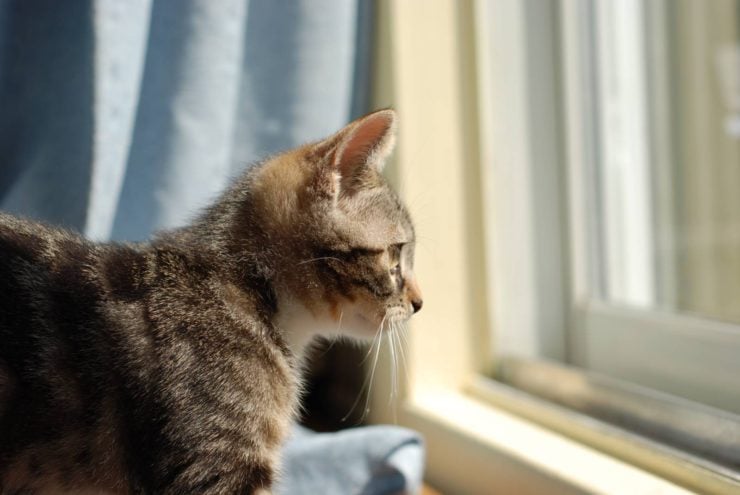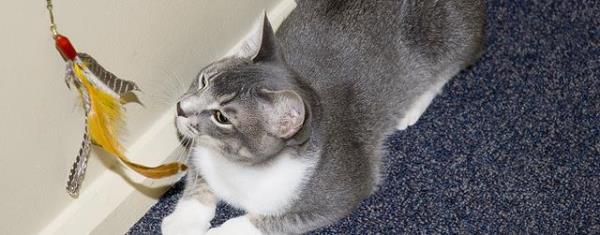It’s a good resolution to keep your cat indoors. At the same time, it may seem an impossible task to stop your cat from going outside if you are like most cat owners.

When you go out, when you come home, or when you try to let fresh air in, your cat is already there and scoots right out at the first possibility. In some cases, you may not even notice that he’s gone.
In this article, you are going to learn nine techniques to stop your cat from going outside and keep him indoors without running out the door, window, or chimney.
- Make it more appealing to be indoors. If you decide to keep your cat inside, you must provide something in return. Regardless of the safety concerns, indoors is still confinement. You must make sure that your home space is perfect for your cat. Best way to make your home more appealing to a cat is to add vertical space. Introduce cat trees, window perches, or allow your cat to climb on top of furniture. You should also provide lots of possibilities for self-play. You can read more about improving your cat’s indoor territory here.
- Introduce more playtime. It not only means you should toss some cat toys around. That is a good thing, but it also means you must play with your cat yourself. How often? Well, it’s not a prescription, so there are no hard rules. The more, the better always applies, but it’s okay if you remember that some time is way better than none at all. Can you add 10 minutes of playtime a day? Every other day? You do not have to play for hours; cats are totally fine with short play sessions if you make them frequent. Cats are born to hunt, and they have a large amount of energy available. If you learn to expend this energy through the use of indoor activities, your cat will have no reason to seek activities outdoors. Besides, many other behavior problems could disappear in a flash if you play with your cat more regularly. You can read about the additional benefits of playing with your cat here.
- Keep your cat’s favorite toy near the door. This way, as you come home, you can grab a toy a get your cats attention on it. It will help if your cat loves to wait at the door for them to open. You can even keep the toy outside the door and grab it on the way in. If your cat is extremely dedicated on going outside, open the door just a little bit, so that you get your cat’s attention before he has a chance to get out. The way you use this technique all depends on your cat’s level of activity and his desire to get out.
- Switch your cat to scheduled feeding, if you haven’t already. How can this help? It’s simple: if you feed your cat every time you arrive home, he will have no desire to go out. Even if he does escape, it will be easy to call him back indoors if he’s hungry. Also, if you feed your cat moments before you leave the house, he will be busy when you open the door. This technique is not possible if your cat’s food is always accessible – and there are also plenty of other reasons why scheduled feeding is better for cats.

A short playing session before each meal will help to keep your cat indoors.
Photo swanksalot, CC BY-SA 2.0 - Train your cat to walk on a leash. It’s not as dumb as it may sound first, as long as you understand that cats walk on a leash differently than dogs do. You can read how to walk your cat on a leash here. Some controlled outdoor exposure will help to keep your cat indoors at other times.
- Build a safe outdoor enclosure where you can place your cat, granting some outdoor access to your cat but preventing him from escaping. This suggestion is excellent if you are good at DIY. If you are, you can build any form, shape, and size of the enclosure you want — but there are also plenty of ready-made solutions on the market. You could also consider approaching a craftsman with a custom order. Aside from leash walking and enclosures, you can read about other ways to let your cat outside safely here.
- Block access to the entrance. If you have a corridor near the front door or a mudroom, keep the doors to it closed. Most cats who crave outdoor access are reported to literally “guard” the front door by their owners. When you go away, feed your cat or play with him before you leave.
- Make the entrance less appealing. Spray-on deterrents, double sticky tape or motion-activated pet deterrents (see our video our favorite one, SSSCat review) are the best ways to achieve this. Don’t try to scare your cat away yourself. You do not want your cat to view you as a scarecrow; it will hurt your relationship. Additionally, we do not promote the use of electricity mats and shock collars to keep your pets out of unwanted areas.
- Ventilate your rooms one by one, closing the door to them and checking whether your cat is outside of that room before you leave. This is a must to prevent the cat from getting out of the window. Don’t rely on the fact that you haven’t seen the cat in that particular room as he may be hiding; check exactly where your cat is. An alternative option is to play with your cat or keep an eye on him as you open the windows. You can play, pet, brush, or hold your cat in your arms while the windows are open. Of course, if you have the funds to invest, you can install mechanical ventilation at your home – it has more benefits, of course than just allowing you to keep your cat indoors. Alternatively, you can install window screens, but make sure they are stronger than insect screens as they won’t keep your cat inside otherwise.

We hope the above gives enough ides to stop your cat from going outside. Unfortunately, there is no guaranteed method to keep your cat indoors — no matter how hard you try, your cat may escape at some point.
So, our final piece of advice is: get an identification tag and microchip your cat. Many people believe indoor cats don’t need one, which isn’t true. Many, many indoor cats escape and get lost due to their lack of outdoor skills, so get an ID tag you can attach to a collar, showing your phone number and the statement “indoor cat”, as well as a microchip, in case the collar and tag comes off.
Identification will not keep your cat indoors, but if he gets away, your chances of being reunited again will rise significantly.
